

Wahweap Hoodoos and Paria Rimrocks, Utah
The Wahweap Hoodoos are accessible via a 9.2 mile round-trip hike from Big Water, UT through the Wahweap Wash. Wahweap means “bitter water” in Paiute and refers to the alkaline seeps found along the canyon.
Hoodoos are eccentric columns of rock formed by differential weathering. The cap of these hoodoos is 100 million-year-old Dakota Sandstone and the columns are Entrada Sandstone that is 160 million-years-old. The Paiutes believed that hoodoos are the remnants of people who were turned to stone.
There are three coves of hoodoos along the wash. The first is known as Riverside Cove and is best viewed from the floor of the wash. The second, called Hoodoo Central, is in a recess on the canyon wall a third of a mile to the west; and the third grouping, known as the Towers of Silence, is around a bend another third of a mile to the north.
©Rich Beckman
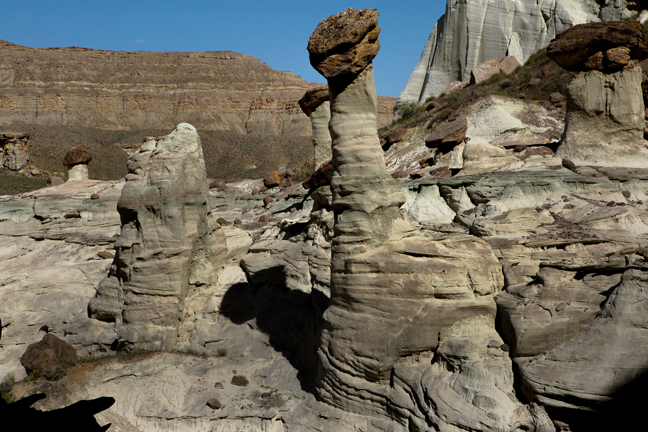

Wahweap Hoodoos and Paria Rimrocks, Utah
The Wahweap Hoodoos are accessible via a 9.2 mile round-trip hike from Big Water, UT through the Wahweap Wash. Wahweap means “bitter water” in Paiute and refers to the alkaline seeps found along the canyon.
Hoodoos are eccentric columns of rock formed by differential weathering. The cap of these hoodoos is 100 million-year-old Dakota Sandstone and the columns are Entrada Sandstone that is 160 million-years-old. The Paiutes believed that hoodoos are the remnants of people who were turned to stone.
There are three coves of hoodoos along the wash. The first is known as Riverside Cove and is best viewed from the floor of the wash. The second, called Hoodoo Central, is in a recess on the canyon wall a third of a mile to the west; and the third grouping, known as the Towers of Silence, is around a bend another third of a mile to the north.
©Rich Beckman
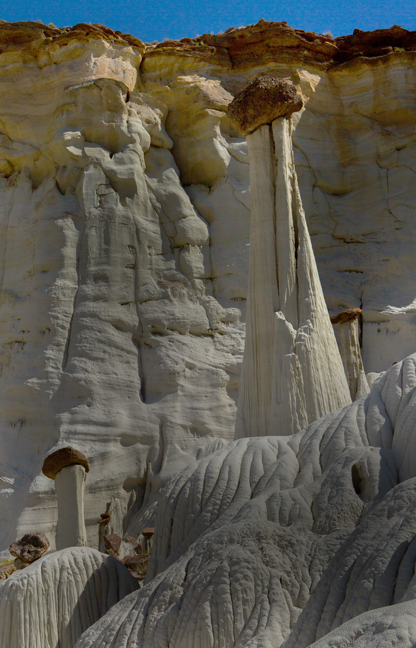

Wahweap Hoodoos and Paria Rimrocks, Utah
The Wahweap Hoodoos are accessible via a 9.2 mile round-trip hike from Big Water, UT through the Wahweap Wash. Wahweap means “bitter water” in Paiute and refers to the alkaline seeps found along the canyon.
Hoodoos are eccentric columns of rock formed by differential weathering. The cap of these hoodoos is 100 million-year-old Dakota Sandstone and the columns are Entrada Sandstone that is 160 million-years-old. The Paiutes believed that hoodoos are the remnants of people who were turned to stone.
There are three coves of hoodoos along the wash. The first is known as Riverside Cove and is best viewed from the floor of the wash. The second, called Hoodoo Central, is in a recess on the canyon wall a third of a mile to the west; and the third grouping, known as the Towers of Silence, is around a bend another third of a mile to the north.
©Rich Beckman
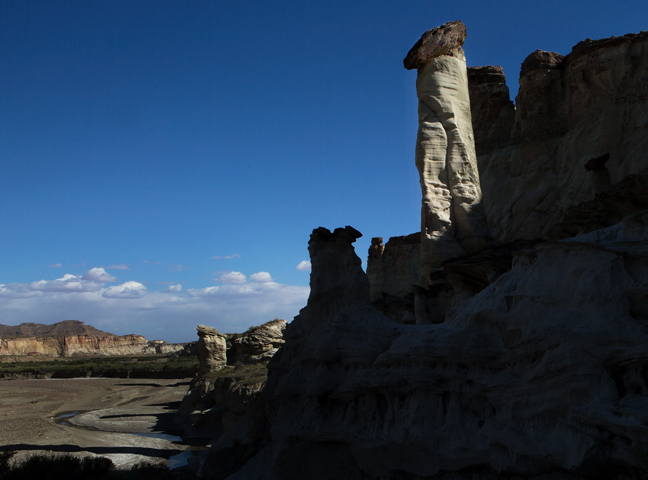

Wahweap Hoodoos and Paria Rimrocks, Utah
The Wahweap Hoodoos are accessible via a 9.2 mile round-trip hike from Big Water, UT through the Wahweap Wash. Wahweap means “bitter water” in Paiute and refers to the alkaline seeps found along the canyon.
Hoodoos are eccentric columns of rock formed by differential weathering. The cap of these hoodoos is 100 million-year-old Dakota Sandstone and the columns are Entrada Sandstone that is 160 million-years-old. The Paiutes believed that hoodoos are the remnants of people who were turned to stone.
There are three coves of hoodoos along the wash. The first is known as Riverside Cove and is best viewed from the floor of the wash. The second, called Hoodoo Central, is in a recess on the canyon wall a third of a mile to the west; and the third grouping, known as the Towers of Silence, is around a bend another third of a mile to the north.
©Rich Beckman
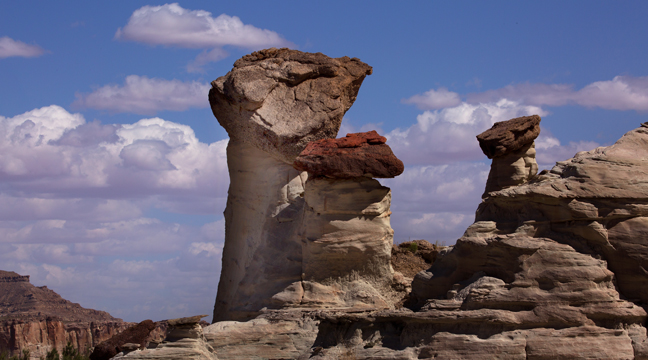

Wahweap Hoodoos and Paria Rimrocks, Utah
The Wahweap Hoodoos are accessible via a 9.2 mile round-trip hike from Big Water, UT through the Wahweap Wash. Wahweap means “bitter water” in Paiute and refers to the alkaline seeps found along the canyon.
Hoodoos are eccentric columns of rock formed by differential weathering. The cap of these hoodoos is 100 million-year-old Dakota Sandstone and the columns are Entrada Sandstone that is 160 million-years-old. The Paiutes believed that hoodoos are the remnants of people who were turned to stone.
There are three coves of hoodoos along the wash. The first is known as Riverside Cove and is best viewed from the floor of the wash. The second, called Hoodoo Central, is in a recess on the canyon wall a third of a mile to the west; and the third grouping, known as the Towers of Silence, is around a bend another third of a mile to the north.
©Rich Beckman
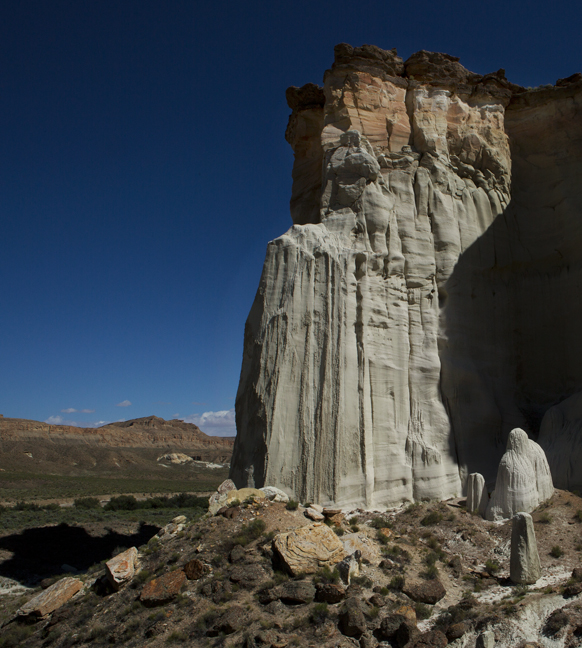

Wahweap Hoodoos and Paria Rimrocks, Utah
The Wahweap Hoodoos are accessible via a 9.2 mile round-trip hike from Big Water, UT through the Wahweap Wash. Wahweap means “bitter water” in Paiute and refers to the alkaline seeps found along the canyon.
Hoodoos are eccentric columns of rock formed by differential weathering. The cap of these hoodoos is 100 million-year-old Dakota Sandstone and the columns are Entrada Sandstone that is 160 million-years-old. The Paiutes believed that hoodoos are the remnants of people who were turned to stone.
There are three coves of hoodoos along the wash. The first is known as Riverside Cove and is best viewed from the floor of the wash. The second, called Hoodoo Central, is in a recess on the canyon wall a third of a mile to the west; and the third grouping, known as the Towers of Silence, is around a bend another third of a mile to the north.
©Rich Beckman
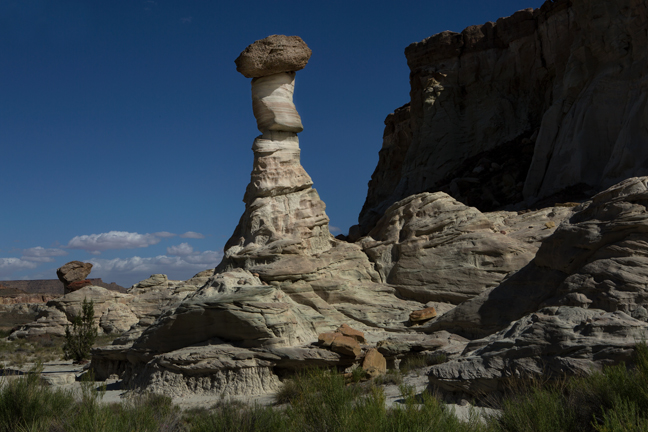

Wahweap Hoodoos and Paria Rimrocks, Utah
The Wahweap Hoodoos are accessible via a 9.2 mile round-trip hike from Big Water, UT through the Wahweap Wash. Wahweap means “bitter water” in Paiute and refers to the alkaline seeps found along the canyon.
Hoodoos are eccentric columns of rock formed by differential weathering. The cap of these hoodoos is 100 million-year-old Dakota Sandstone and the columns are Entrada Sandstone that is 160 million-years-old. The Paiutes believed that hoodoos are the remnants of people who were turned to stone.
There are three coves of hoodoos along the wash. The first is known as Riverside Cove and is best viewed from the floor of the wash. The second, called Hoodoo Central, is in a recess on the canyon wall a third of a mile to the west; and the third grouping, known as the Towers of Silence, is around a bend another third of a mile to the north.
©Rich Beckman
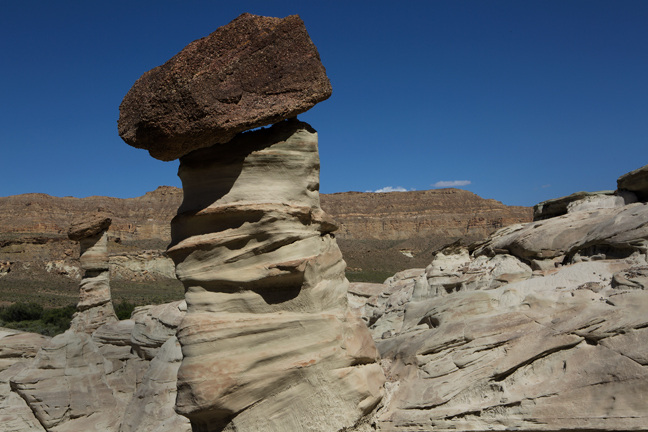

Wahweap Hoodoos and Paria Rimrocks, Utah
The Wahweap Hoodoos are accessible via a 9.2 mile round-trip hike from Big Water, UT through the Wahweap Wash. Wahweap means “bitter water” in Paiute and refers to the alkaline seeps found along the canyon.
Hoodoos are eccentric columns of rock formed by differential weathering. The cap of these hoodoos is 100 million-year-old Dakota Sandstone and the columns are Entrada Sandstone that is 160 million-years-old. The Paiutes believed that hoodoos are the remnants of people who were turned to stone.
There are three coves of hoodoos along the wash. The first is known as Riverside Cove and is best viewed from the floor of the wash. The second, called Hoodoo Central, is in a recess on the canyon wall a third of a mile to the west; and the third grouping, known as the Towers of Silence, is around a bend another third of a mile to the north.
©Rich Beckman
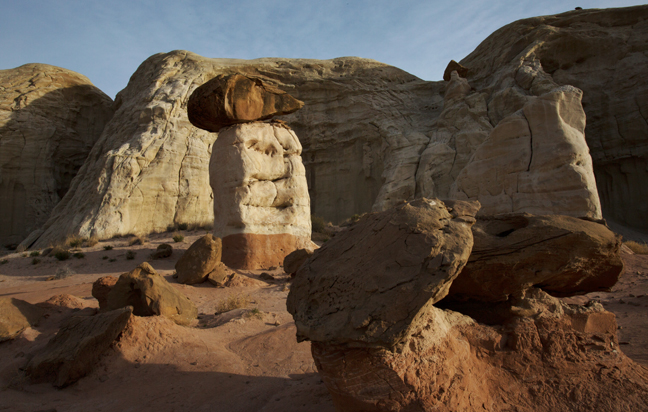

Wahweap Hoodoos and Paria Rimrocks, Utah
The Toadstool Hoodoos, featuring the Red Toadstool, are part of the Paria Rimrocks in the southwest corner of Grand Staircase-Escalante National Monument outside of Big Water, Utah. A toadstool is a spire-like feature with a boulder perched atop a pedestal rock that formed when softer rock eroded leaving a dense column.
The trailhead access is via a roadside pullout along Hwy. 89, but when we arrived in November 2019, numerous cars had been burglarized, their windows broken and purses and possessions stolen. The police were already on the scene, but caution is advised.
©Rich Beckman


Wahweap Hoodoos and Paria Rimrocks, Utah
The Toadstool Hoodoos, featuring the Red Toadstool, are part of the Paria Rimrocks in the southwest corner of Grand Staircase-Escalante National Monument outside of Big Water, Utah. A toadstool is a spire-like feature with a boulder perched atop a pedestal rock that formed when softer rock eroded leaving a dense column.
The trailhead access is via a roadside pullout along Hwy. 89, but when we arrived in November 2019, numerous cars had been burglarized, their windows broken and purses and possessions stolen. The police were already on the scene, but caution is advised.
©Rich Beckman


Wahweap Hoodoos and Paria Rimrocks, Utah
The Toadstool Hoodoos, featuring the Red Toadstool, are part of the Paria Rimrocks in the southwest corner of Grand Staircase-Escalante National Monument outside of Big Water, Utah. A toadstool is a spire-like feature with a boulder perched atop a pedestal rock that formed when softer rock eroded leaving a dense column.
The trailhead access is via a roadside pullout along Hwy. 89, but when we arrived in November 2019, numerous cars had been burglarized, their windows broken and purses and possessions stolen. The police were already on the scene, but caution is advised.
©Rich Beckman


Wahweap Hoodoos and Paria Rimrocks, Utah
The Toadstool Hoodoos, featuring the Red Toadstool, are part of the Paria Rimrocks in the southwest corner of Grand Staircase-Escalante National Monument outside of Big Water, Utah. A toadstool is a spire-like feature with a boulder perched atop a pedestal rock that formed when softer rock eroded leaving a dense column.
The trailhead access is via a roadside pullout along Hwy. 89, but when we arrived in November 2019, numerous cars had been burglarized, their windows broken and purses and possessions stolen. The police were already on the scene, but caution is advised.
©Rich Beckman
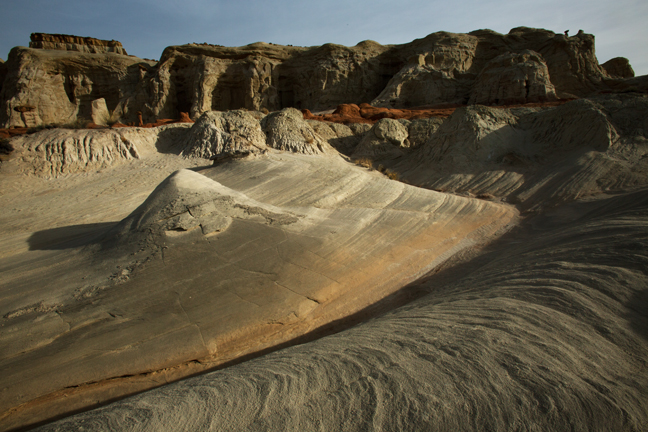

Wahweap Hoodoos and Paria Rimrocks, Utah
The Toadstool Hoodoos, featuring the Red Toadstool, are part of the Paria Rimrocks in the southwest corner of Grand Staircase-Escalante National Monument outside of Big Water, Utah. A toadstool is a spire-like feature with a boulder perched atop a pedestal rock that formed when softer rock eroded leaving a dense column.
The trailhead access is via a roadside pullout along Hwy. 89, but when we arrived in November 2019, numerous cars had been burglarized, their windows broken and purses and possessions stolen. The police were already on the scene, but caution is advised.
©Rich Beckman
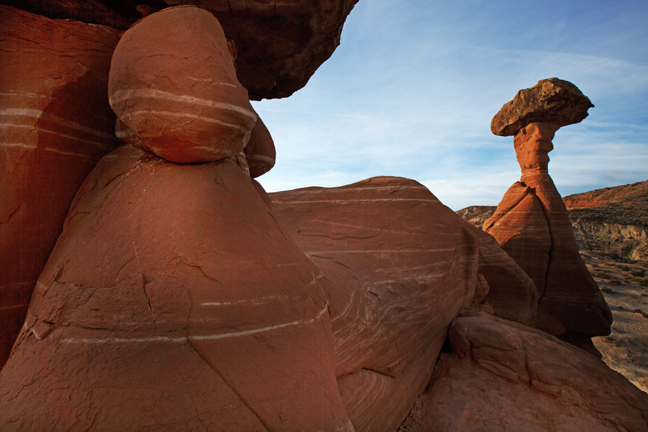

Wahweap Hoodoos and Paria Rimrocks, Utah
The Toadstool Hoodoos, featuring the Red Toadstool, are part of the Paria Rimrocks in the southwest corner of Grand Staircase-Escalante National Monument outside of Big Water, Utah. A toadstool is a spire-like feature with a boulder perched atop a pedestal rock that formed when softer rock eroded leaving a dense column.
The trailhead access is via a roadside pullout along Hwy. 89, but when we arrived in November 2019, numerous cars had been burglarized, their windows broken and purses and possessions stolen. The police were already on the scene, but caution is advised.
©Rich Beckman
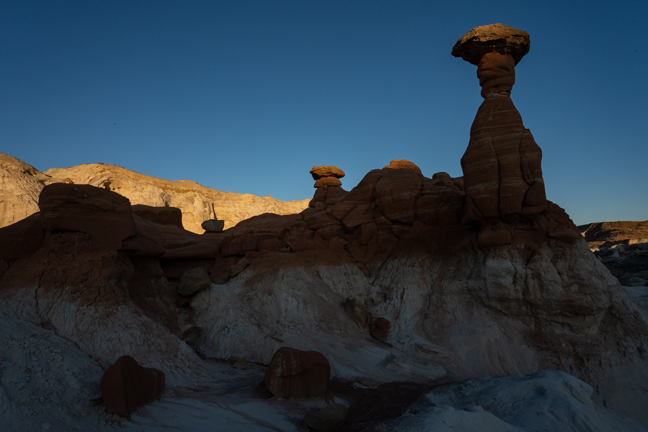

Wahweap Hoodoos and Paria Rimrocks, Utah
The Toadstool Hoodoos, featuring the Red Toadstool, are part of the Paria Rimrocks in the southwest corner of Grand Staircase-Escalante National Monument outside of Big Water, Utah. A toadstool is a spire-like feature with a boulder perched atop a pedestal rock that formed when softer rock eroded leaving a dense column.
The trailhead access is via a roadside pullout along Hwy. 89, but when we arrived in November 2019, numerous cars had been burglarized, their windows broken and purses and possessions stolen. The police were already on the scene, but caution is advised.
©Rich Beckman
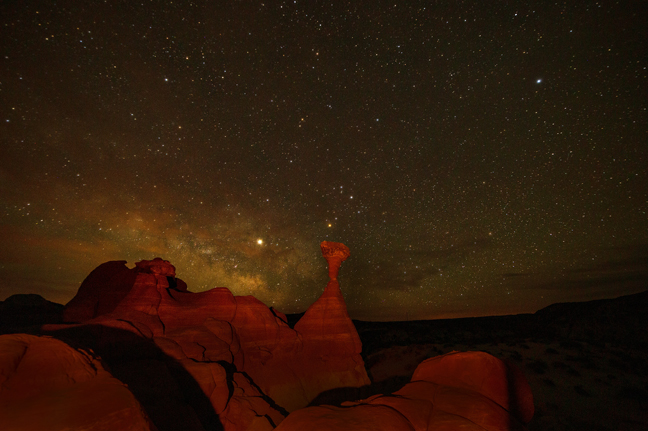

Wahweap Hoodoos and Paria Rimrocks, Utah
The Toadstool Hoodoos, featuring the Red Toadstool, are part of the Paria Rimrocks in the southwest corner of Grand Staircase-Escalante National Monument outside of Big Water, Utah. A toadstool is a spire-like feature with a boulder perched atop a pedestal rock that formed when softer rock eroded leaving a dense column.
The trailhead access is via a roadside pullout along Hwy. 89, but when we arrived in November 2019, numerous cars had been burglarized, their windows broken and purses and possessions stolen. The police were already on the scene, but caution is advised.
©Rich Beckman